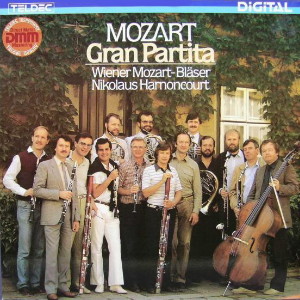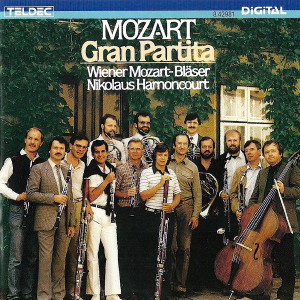 |
1 LP -
6.42981 AZ - (p) 1984
|
 |
| 1 CD -
8.42981 ZK - (p) 1984 |
|
| Wolfgang
Amadeus Mozart (1756-1791) |
|
|
|
|
|
|
|
Serenade Nr. 10 B-dur, KV 361
(370a) "Gran Partita"
|
|
49' 52" |
|
- Largo - Molto Allegro
|
10' 02" |
|
A1 |
| - Menuetto
- Trio I - Trio II |
9' 30" |
|
A2 |
| - Adagio |
4' 20" |
|
A3 |
- Menuetto: Allegretto -
Trio I - Trio II
|
4' 16" |
|
A4 |
- Romance: Adagio -
Allegretto
|
8' 08" |
|
B1 |
- (Tema con 6 variazioni:
Andante)
|
10' 14" |
|
B2 |
- Finale: Molto Allegro
|
3' 22" |
|
B3 |
|
|
|
|
Wiener
Mozart-Bläser
|
|
| -
Jürg
Schaeftlein, Oboe |
-
Milan Turković, Fagott |
|
| -
Klaus Lienbacher, Oboe |
-
Wolfgang Kuttner, Fagott |
|
| -
Alois Brandhofer, Klarinette |
-
Elmar Eisner, Horn |
|
| -
Wilfried Gottwald, Klarinette |
-
Alois Schlor, Horn |
|
| -
Hans-Rudolf Stalder, Bassetthorn |
-
Volker Altmann, Horn |
|
| -
Elmar Schmid, Bassetthorn |
-
Michael Höltzel, Horn |
|
| -
Klaus Stoll, Kontrabaß |
|
|
|
|
| Nikolaus
Harnoncourt, Gesamtleitung |
|
|
|
Luogo
e data di registrazione
|
(Luogo
e data di registrazione non indicati)
|
|
Registrazione
live / studio
|
| studio |
Producer
/ Engineer
|
-
|
Prima Edizione CD
|
| Teldec
- 8.42981 ZK - (1 cd) - 49' 52" - (p)
1984 - DDD |
Prima
Edizione LP
|
Teldec - 6.42981
AZ - (1 lp) - 49'
52"
- (p) 1984 -
Digital
|
|
|
Notes
|
Mozart Serenade or "Gran
Partita" K. 361 has no original
title: the Term "partita" was not
common at the end of the 18th
century and was presumably conied
shortly after the composer's
death. The work was probably
written at the beginning of 1784
in Vienna and intended for a
benefit concert given by the
clarinettist Anton Stadler on 23rd
March 1784 in the Burgtheater.
Mozart's composition was evidently
conceived as the
principal attraction of the
concert; the journal "Wienerblättchen" for
23rd March announced. "Today
Herr Stadler senior will give a
musical academy for his own
benefit in the Imperial and
Royal Hoftheater in the
ellustrious service of his
Imperial Majesty, as which among
other wellchosen pieces a most
especial large wind musick by
Herr Mozart will be played".
Alongside
Stadler who played first
clarinet, the performers
included with fair certainly
his younger brother Johann
(second clarinet) and the two
bassethorn players Anton David
and Vinzent Springer. (The
earliest record of Mozart's
contact with the latter two
musicians only dates from
October 1785. it is true, but
it is hard to imagine the
performance of the Serenade
in Stadler's concert without
the presence of two good
clarinettists and two good
basset-horn players.)
However, the work was not
played complete on this
occasion - in 1785 the Graz
writer Johann Friedrich
Schink reported of his visit
to Vienna in the spring of
1784: "I also heard a piece
of music with wind
instruments today by Herr
Mozart, in four movements -
magnidicent and sublime! The
ensemble consisted of
thirteen instruments - four
corni, two oboi, two
fagotti, two clarinetti, two
basset-corni and one
contreviolon - and every one
was played by a master
musican! O, what an effect!
Magnificent and gradiose,
exquisite and sublime!".
The exact
details of the instruments
played leave no doubt that
what Schink heard was four
movements of the Serenade,
and they also answeer the
oft-discussed question,
whether the bass
instrument (in the
autograph "Contra Basso")
was supposed to be a
double-bass or a
double-bassoon:
the singular mixing of the
wind sound (which
dominates throughout) with
a stringed instrument as a
bass foundation is
international. The choice
of instrument was
presumably also influenced
by the players available
for Stadler's benefic
concert, and there can
scarcely be any further
doubt that the work was
written for this concert
after the thoroughgoing
investigation understaken
by Messrs. Leeson and
Whitwell and published in
the Mozart Yearbook
1976/77.
The
fact that Stadler did
not perform the work in
its entirety, altough it
was written for him, has
an explanation as semple
as it is charactestic:
the piece was too long
(it lasts almost an hour
with all the prescribed
repeats), and was also
something quite
different in content
from what a Viennese
audience expected from a
"wind musick" - indeed,
the concert announcement
remarks by way of
precautional that it
is a "most especial
musick". As so often
happened, Mozart lost
sight of the occasion
for which the work was
destined when it come
to writing it down;
the result was a
"serenade"
for which there are
only two roughty compatable
pieces in the entire
classical repertoire
- Mozart's own wind
serenades in E flat
major K,. 375 and in
C minor K. 384a/388.
Even these two works
are more
conventional in
form, if not in
content. K. 375 has
the five-movement
divertimento form
(fast - minuet -
adagio - minuet -
fast) probably
established by
Haydn, while K.
384a/388 has the
normal four-movement
sonata form. The B
flat major Serenade,
on the other hand,
comprises seven
movements. The
divertimento form
still shimmers
through, however if
this romanza (5) and
the variations
movement (6) are
removed, one is left
with a five-movement
divertimento form.
But even this is -
in comparison with
K. 375 - increased
in "value" by the
slow introduction
and the dimensions
of the first
movement, which are
nothing short of
symphonic, as well
as by the expansion
of both minuets into
five-part structure
by the addition of a
second trio in each
case.
Admittedly
the exceptional
dimensions of the
work and the
almost symphonic
air it bresthes
are only one side
of the coin. The
other side is that
Mozart on the one
hand does not
sacrifice to such
special features
the serenade
character, the
element of
playfulness and -
on the highest
level - the
entertainment
aspect of the
genre, and on the
other hand he
explores to the
full the potential
of such rich and
"colourful"
instrumentation in
inexhaustible
variations of the
timbres and the
combinations of
instruments, in a
kind of musical
soliloquy that
gives the work a
chamber-music
undertone in
addition to
everything else.
Characteristic
instances of this
undertone are
details such as
the chromatic
nuances of the
first motif in the
development and
particularly the
coda of the first
allegro, the first
trio of the first
minuet, the B flat
minor variation of
the penultimate
movement and,
above all, the
centre of the
work, the E flat
major adagio; the
tonal sensuosness
and magic found
here have
parallels at the
most in some of
the slow movements
of the piano
concerti. No less
characteristic is
the way the danger
of monotony in the
two minuets -
which should be in
the basic key of B
flat major
according to the
"rules" - is
banished by giving
each of the four
trios its own
instrumentation
and highly
individual "sound"
and also, as a
counterweight to
the unvaried B
flat major of the
main sections, its
own key: E flat
major and G minor
in the first
minuet, B flat
minor and F major
in the second. The
unique qualities
of this music, however,
and the singular
delicate balance
of the whole
work - in every
breath
"entertainment"
and great art at
the same time -
cannot be
conveyed by
painstaking
analysis, but by
listening alone.
Ludwing
Finscher
Translation: Clive R. Williams
----------
When
the wind
ensemble
"WIENER
MOZART-BLÄSER"
was formed,
the emphasis
of the
Viennese
elements with
the best
possible
players seemed
to us ideal
for an
adequate
interpretation
pf the
Mozartian
musical idiom
according to
the present
concept. In
this
connection, we
were less
interested in
membership of
a particular
orchestra than
in a manner of
playing at
once
stylistically
homogeneous
yet having
soloistic
tendencies.
The sound of
the typical
Viennese wind
ensemble today
is determined
chiefly by the
oboes and
horns, since
the Viennese
instruments
differ very
considerably
from those
used
elsewhere.
The
outcome of
these
deliberations
was an
ensemble in
which leading
wind players
from the
Vienna
Symphony
Orchestra were
supplemented
by specialists
experienced in
chamber music,
such as the
sought-after
basset horn
duo
Hans-Rudolf
Stalder and
Elmar Schmid,
the Detmold
horn professor
Michael Höltzel
(well-known
for his
familiarity
with the
Viennese horn)
and Volker
Altmann from
the Vienna
Philharmonic,
who has a
great deal of
experience in
the low horn
register to
his credit. In
arranging the
double-bass
part we were
concerned to
arrive at a
highly
colourful
complement to
the wind
ensemble,
bringing the
double-bass
out of the
background
position it
normally
maintains.
Klaus Stoll of
the Berlin
Philharmonic
used a
four-string
bass built in
1610 by the
Brescia master
Paolo Maggini
for the
recording -
the instrument
comes from the
collection of
the famous
virtuoso
Domenico
Dragonetti.
Milan
Turković
Translation: Clive R. Williams
|
|
Nikolaus
Harnoncourt (1929-2016)
|

|

|
|